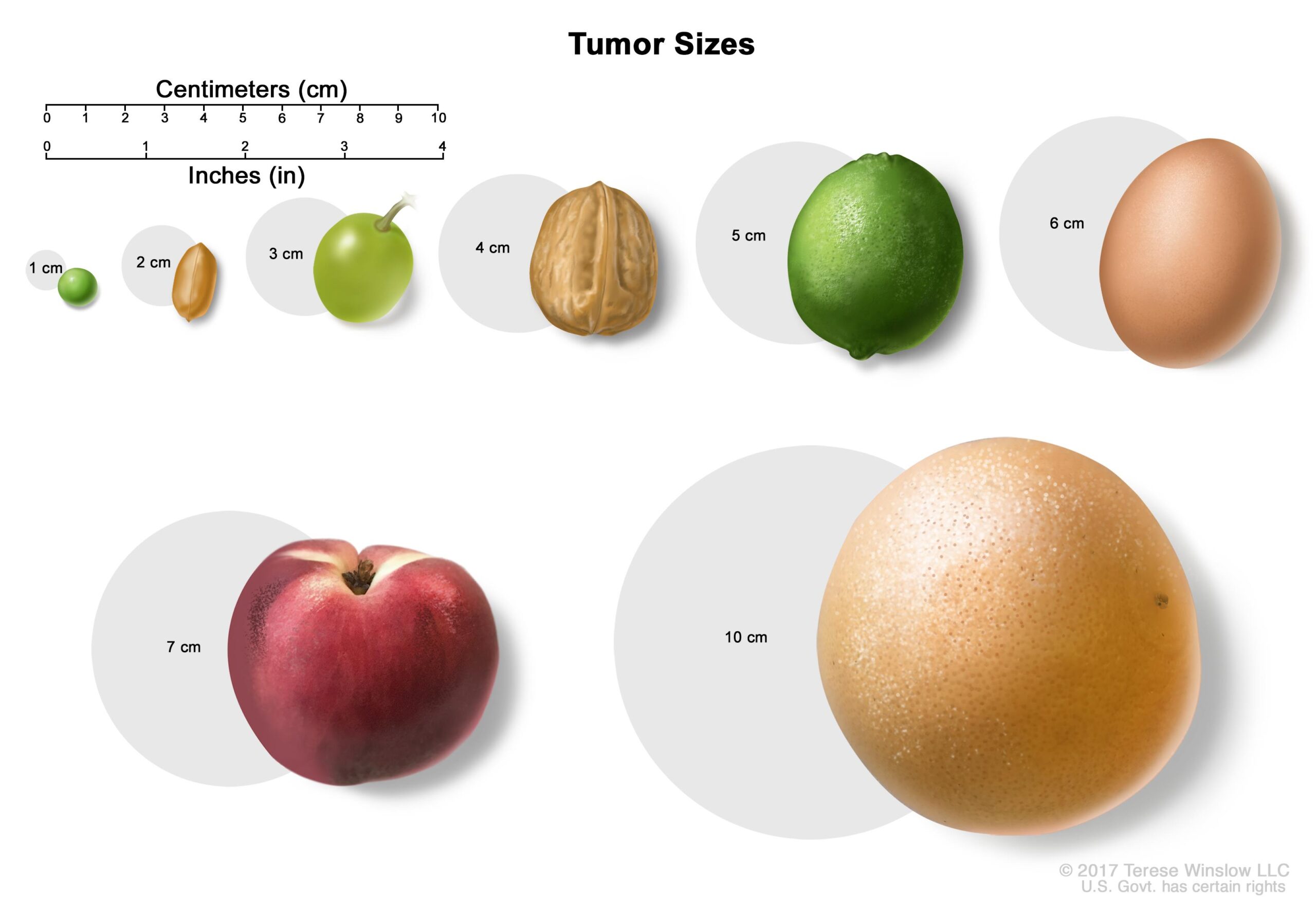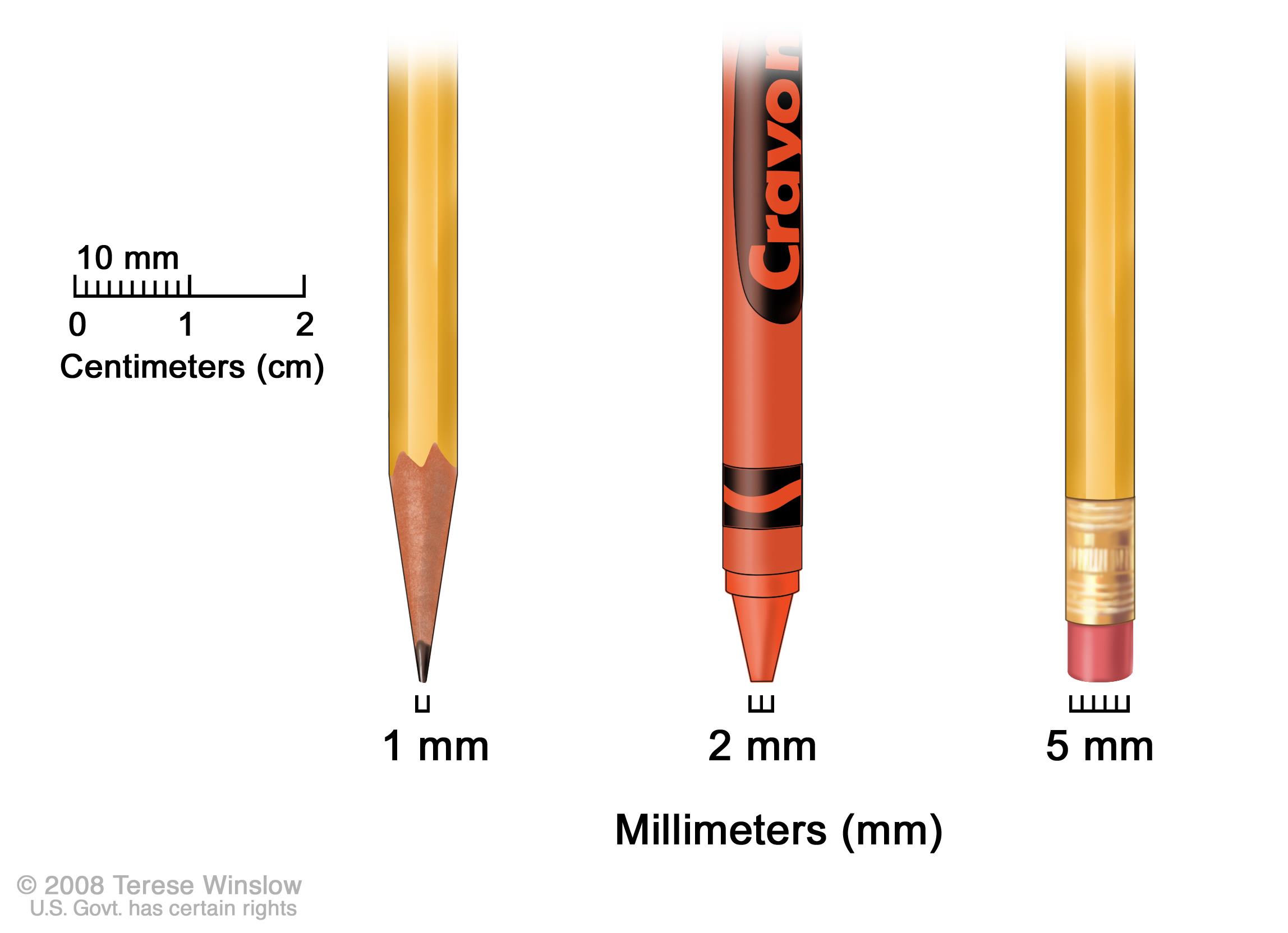CANCER STAGES CAN BE COMPLEX
Staging Perihilar (Hilar or Klatskin Tumor) Cholangiocarcinoma
Perihilar (also called hilar) cholangiocarcinomas develop at the hilum, where the hepatic ducts have joined and are just leaving the liver. They are also called Klatskin tumors. These are the most common type of bile duct cancer, making up 6 or 7 of every 10 cholangiocarcinomas. These cancers are grouped with distal bile duct cancers as extrahepatic bile duct cancers.

TUMOR SIZES (CM)
Tumor sizes are often measured in centimeters (cm) or inches. Common food items that can be used to show tumor size in cm include: a pea (1 cm), a peanut (2 cm), a grape (3 cm), a walnut (4 cm), a lime (5 cm or 2 inches), an egg (6 cm), a peach (7 cm), and a grapefruit (10 cm or 4 inches).

TUMOR SIZES (MM)
Tumor sizes measured in millimeters (mm). A sharp pencil point is about 1 mm, a new crayon point is about 2 mm, and a new pencil eraser is about 5 mm. Click below to learn more
HOW CANCER SPREADS
Many cancer deaths are caused when cancer moves from the original tumor and spreads to other tissues and organs. This is called metastatic cancer. This animation shows how cancer cells travel from the place in the body where they first formed to other parts of the body.
graphics and video courtesy of cancer.gov
After a person is diagnosed with perihilar (hilar) bile duct cancer, doctors will try to figure out if it has spread, and if so, how far. This process is called staging. The stage of a cancer describes how much cancer is in the body. It helps determine how serious the cancer is and how best to treat it. Doctors also use a cancer’s stage when talking about survival statistics.
The earliest stage perihilar bile duct cancers are stage 0, also called carcinoma in situ (CIS) or high-grade biliary intraepithelial neoplasia. Stages then range from stages I (1) through IV (4). As a rule, the lower the number, the less the cancer has spread. A higher number, such as stage IV, means cancer has spread more. And within a stage, an earlier letter means a lower stage.
Although each person’s cancer experience is unique, cancers with similar stages tend to have a similar outlook and are often treated in much the same way.
How is the stage determined?
The staging system most often used for intrahepatic bile duct cancer is the American Joint Committee on Cancer (AJCC) TNM system, which is based on 3 key pieces of information:
- The extent (size) of the main tumor (T): How large has the cancer grown? Has the cancer reached nearby structures or organs?
- The spread to nearby lymph nodes (N): Has the cancer spread to nearby lymph nodes?
- The spread (metastasis) to distant sites (M): Has the cancer spread to distant lymph nodes or distant organs such as the bones, lungs, or peritoneum (the lining of the abdomen)?
Numbers or letters after T, N, and M provide more details about each of these factors. Higher numbers mean the cancer is more advanced.
Once a person’s T, N, and M categories have been determined, this information is combined in a process called stage grouping to assign an overall stage.
Intrahepatic bile duct cancer is typically given a clinical stage based on the results of a physical exam, biopsy, and imaging tests. If surgery is done, the pathologic stage (also called the surgical stage) is determined by examining the tissue removed during the operation.
Cancer staging can be complex, so ask your doctor to explain it to you in a way you understand.
This system described below is the most recent AJCC system, effective January 2018.
T Categories for Distal Extrahepatic Bile Duct Cancer
No description of the tumor’s extent is possible because of incomplete information.
There is no evidence of a primary tumor.
Cancer cells are limited to the mucosa (the innermost layer of the bile duct) and have not invaded deeper layers of the bile duct. This stage is also known as intramucosal carcinoma and was previously called carcinoma in situ.
The cancer has grown into deeper layers of the bile duct wall such as the muscle layer or the fibrous tissue layer, but it is still only in the bile duct.
Split into 2 groups
T2a
The tumor has grown through the wall of the bile duct and into surrounding fat.
T2b
The tumor has grown through the wall of the bile duct and into nearby liver tissue.
The cancer is growing into one side of the branches of the main blood vessels of the liver either left or right (the main blood vessels of the liver are the portal vein and/or the hepatic artery).
The cancer is growing into the main blood vessels of the liver (the portal vein and/or the common hepatic artery), OR into both sides of the branches of these vessels(left and right) , OR the cancer is growing directly into other bile ducts on one side (left or right) while the other side of the tumor is growing into one of the main blood vessels.
N Categories
Regional (nearby) lymph nodes cannot be assessed.
The cancer has not spread to nearby lymph nodes.
The cancer has spread to 1 to 3 nearby lymph nodes.
The cancer has spread to 4 or more nearby lymph nodes.
M Categories
The cancer has not spread to tissues or organs far away from the bile duct.
The cancer has spread to tissues or organ far away from the bile duct such as lung, bone, brain and/or distant parts of the liver.
Stage Grouping
Once a patient’s T, N, and M categories have been determined, this information is combined in a process called stage grouping. The stage is expressed in Roman numerals from stage 0 (the least advanced stage) to stage IV (the most advanced stage). Some stages are subdivided with letters.
(Tis, N0, M0)
The cancer cells are only growing in the mucosa (the innermost layer of the bile duct) (Tis) and have not grown into deeper layers of the bile ducts or any nearby organs or structures. It has not spread to lymph nodes (N0) or distant sites (M0).
(T1, N0, M0)
The cancer has grown into deeper layers of the bile duct wall, such as the muscle layer or the fibrous tissue layer (T1). It has not spread to lymph nodes (N0) or distant sites (M0).
(T2a, N0, M0) OR (T2b, N0, M0)
The tumor has grown through the wall of the bile duct and into surrounding nearby fat (T2a) or into the nearby liver tissue (T2b). It has not spread to lymph nodes (N0) or distant sites (M0).
(T3, N0, M0)
The cancer is growing into one side of the branches of the main blood vessels of the liver either left or right (the main blood vessels of the liver are the portal vein and/or the hepatic artery) (T3). It has not spread to lymph nodes (N0) or distant sites (M0).
(T4; N0; M0)
The cancer is growing into the main blood vessels of the liver (the portal vein and/or the common hepatic artery), OR into both sides of the branches of these vessels(left and right) , OR the cancer is growing directly into other bile ducts on one side (left or right) while the other side of the tumor is growing into one of the main blood vessels (T4). It has not spread to lymph nodes (N0) or distant sites (M0).
(Any T, N1, Mo)
The cancer is of any size and might or might not be growing outside the bile duct or into nearby blood vessels (Any T) and it has spread to 1 to 3 nearby lymph node (N1). It has not spread to distant sites (M0).
(Any T, N2, M0)
The cancer is of any size and might or might not be growing outside the bile duct or into nearby blood vessels (Any T) and it has spread to 4 or more nearby lymph node (N2). It has not spread to distant sites (M0).
(Any T, any N, M1)
The cancer is of any size and might or might not be growing outside the bile duct or into nearby blood vessels (Any T). It might or might note spread to nearby lymph node (Any N). It has spread to distant sites such as lung, bone, brain and/or distant parts of the liver (M1).
Adapted from the American Cancer Society